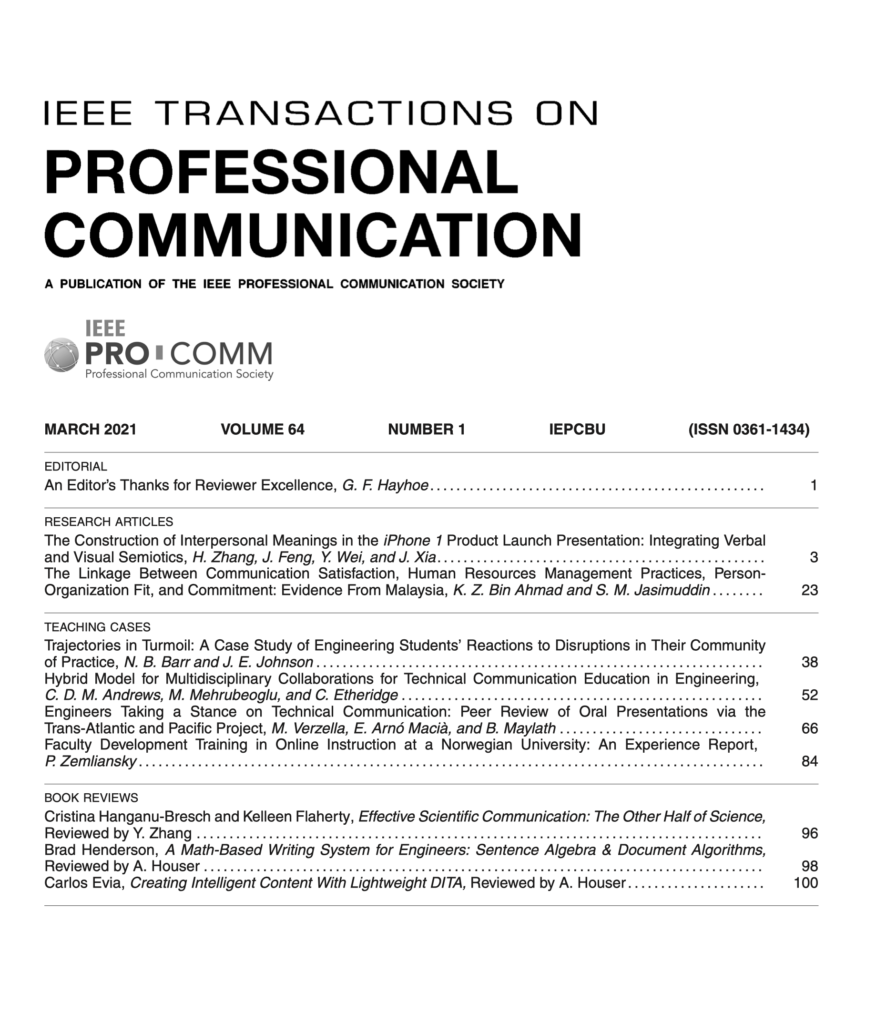The March 2021 of IEEE Transactions on Professional Communication is Now Available
Published on April 6, 2021
Volume 64, Number 1, March 2021

Research Articles:
The Construction of Interpersonal Meanings in the iPhone 1 Product Launch Presentation: Integrating Verbal and Visual Semiotics, by H. Zhang, J. Feng, Y. Wei, and J. Xia
Discourse bridges between speaker and audience in product launches, but how verbals and visuals work together to construct interpersonal meanings in such communication has been largely underexplored. This study integrates Halliday’s Systemic Functional Grammar and Kress and van Leeuwen’s Systemic Visual Grammar to conduct both verbal and visual analyses to explore the construction of interpersonal meanings in the iPhone 1 launch presentation. Analysis of the verbal strategies suggests that Steve Jobs built roles as an authority innovation leader and as a close “friend” engaging with the audience. By combining verbal semiotics with the arrangement of image act, size of frame, and angle, the video creates offer contact, produces close social distance, and presents equal and objective attitudes to further enhance the construction of interpersonal meanings. These factors contribute to the audience’s understanding and recognition of the innovative product.
The Linkage between Communication Satisfaction, Human Resources Management Practices, Person-Organization Fit, and Commitment: Evidence from Malaysia, by K. Z. Bin Ahmad and S. M. Jasimuddin
The paper explores the previously undiscovered relationship between communication satisfaction, human resources management practices, person-organization fit, and affective commitment among full-time Malaysian employees in the service industry. A structural equation model using partial least squares was used to study the impact of human resources management practices and person-organization fit on the linkage between communication satisfaction and AC among 195 full-time employees from various organizations in the service sector in Malaysia. Results: The results suggest that high communication satisfaction leads to positive perceptions of HRM practices, which, in turn, lead to favorable perceptions of person-organization fit and then ultimately to high affective commitment.
Teaching Cases:
Trajectories in Turmoil: A Case Study of Engineering Students’ Reactions to Disruptions in Their Community of Practice, by N. B. Barr and J. E. Johnson
The loss of in-person instruction during the COVID-19 pandemic was difficult for engineering students in practice-based courses as they lost the courses’ hands-on aspect, which is essential for reinforcing theoretical concepts. They also lost the support provided through daily interactions with peers and instructors. In this teaching case, students in a required four-course practice-based mechanical engineering sequence shared their perspectives via reflective portfolio essays on how the change affected their ability to participate in learning communities and negotiate meaningful learning experiences. Their concerns varied depending on their position in the course sequence and the course; however, most felt that the loss of in-person interaction was most detrimental and disruptive in the transition online and resulted in communication and teaming issues.
Hybrid Model for Multidisciplinary Collaborations for Technical Communication Education in Engineering, by C. D. M. Andrews, M. Mehrubeoglu, and C. Etheridge
Engineering programs must take creative approaches to ensure that students get needed communication instruction in curricula constantly pressured by accreditation, state, and industry requirements: expectations for knowledge and skills increase although curricula are compressed. In this case, technical and professional writing and engineering faculty developed a hybrid model, including collaborative workshops, specialized writing center support, and other interventions. The model enabled students to experience a variety of writing interventions that students perceived as beneficial. They found that the most effective interventions occurred in the context of engineering course work. Faculty and administrators found the approach beneficial because of its collaborative nature and its balancing of instructional time with external support methods.
Engineers Taking a Stance on Technical Communication: Peer Review of Oral Presentations via the Trans-Atlantic and Pacific Project, by M. Verzella, E. Arnó Macia, and B. Maylath
Technical communication classes in Spain and the US engaged in an international telecollaborative project between cross-cultural virtual teams in which students in Spain developed oral presentations that were then peer-reviewed by counterparts in the US. In this case, data were analyzed from feedback forms used by US students to evaluate oral presentations, and on pre-learning and post-learning reports completed by students in Spain, as well as from class discussions accompanying the project. Through reflections on pragmatic strategies that facilitate exchange and collaboration in English as a lingua franca, the engineering students became more fully aware of the importance of rhetorical and linguistic factors that affect meaning-making for engineers internationally.
Faculty Development Training in Online Instruction at a Norwegian University: An Experience Report, by P. Zemliansky
This case reports on the design and delivery of faculty training on teaching online at a Norwegian university during the COVID-19 pandemic. Two online and one face-to-face 2-hour training sessions were delivered to three groups of faculty. The training focused on building interactive online courses, providing formative feedback for students, and choosing between synchronous and asynchronous teaching. Pre-training meetings and post-training reflection were used as informal data sources to develop the training sessions and to holistically discuss the themes that emerged from the training. Challenges included convincing participants to shift from lecture as the main instruction method to more interactive and active techniques, as well as reconciling the standardized course study plans with individual teachers’ instructional needs.

